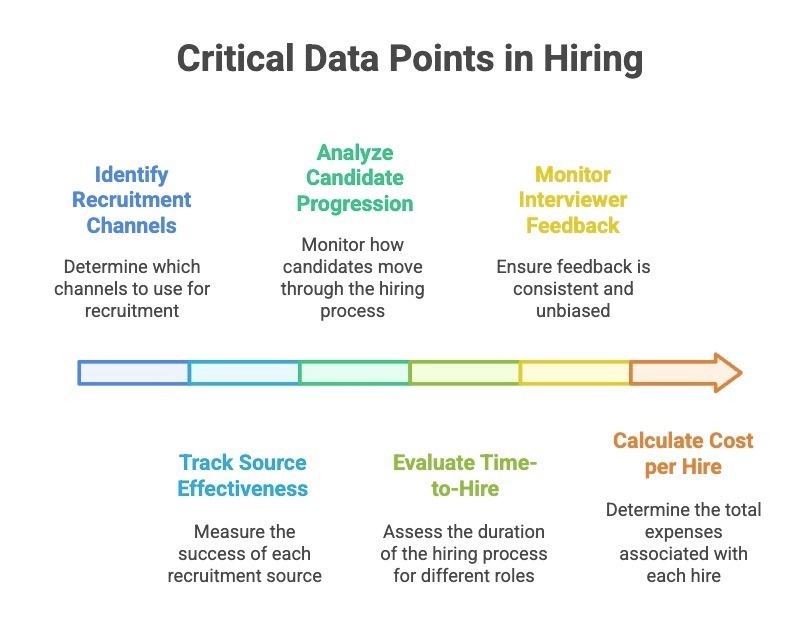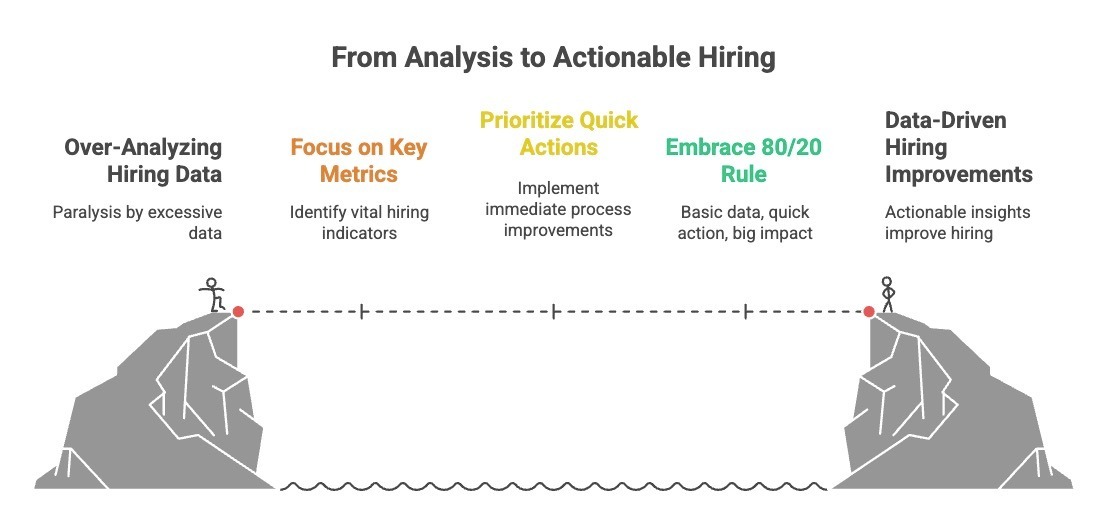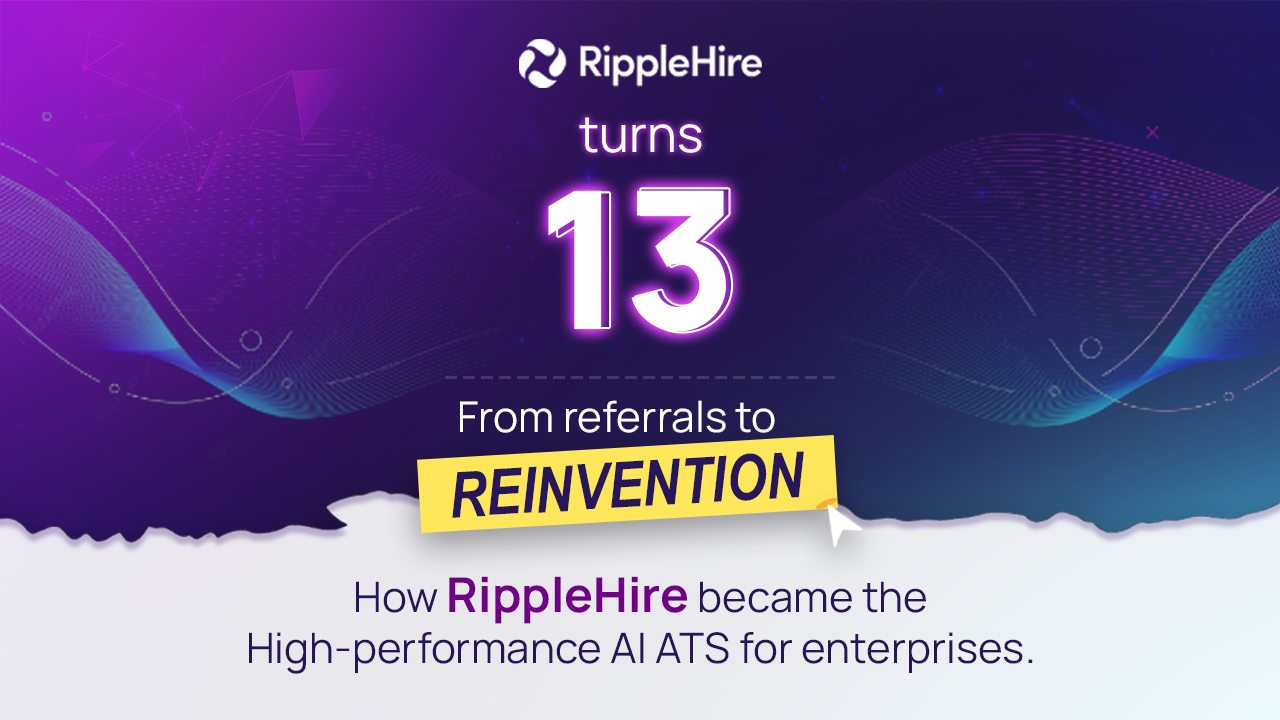Hiring drive data collection: What to track and common mistakes to avoid
The difference between companies that hire great talent consistently and those that struggle isn't bigger recruitment budgets or premium job portals. It's the specific data they capture during each hiring drive that gives them a clear advantage.
The right hiring data doesn't just fill positions faster—it predicts candidate success, reduces recruitment costs, and builds stronger teams. This guide breaks down exactly which hiring data you should collect, when to capture it, and how this information drives better recruitment decisions that impact your bottom line.
5 critical data points to track in every hiring drive

1. Source effectiveness and candidate quality
Most companies spread their recruitment efforts across multiple channels such as job boards, social media, employee referrals, and recruitment agencies, without knowing which sources deliver quality candidates. Tracking source effectiveness means measuring not just application volume, but conversion rates at each hiring stage.
Key metrics to capture:
- Application-to-interview conversion rate by source
- Interview-to-offer conversion rate
- Offer acceptance rates
- Time-to-hire variations by channel
- Cost per hire by source
The data often reveals surprising patterns. LinkedIn might generate 50% of your applications but only 10% of your successful hires, while employee referrals could account for just 15% of applications yet 40% of quality hires.
Without this tracking, you'll continue investing time and budget in channels that feel productive but don't actually deliver results. Smart companies use this data to reallocate recruitment spending toward sources that consistently bring candidates who progress through the hiring funnel and accept offers.
2. Candidate progression and drop-off points
Your hiring funnel has leaks, and they're costing you top talent.
Every step in your hiring process, from application submission to final offer, creates an opportunity for candidates to drop out. The challenge is identifying exactly where you're losing the best people and why it's happening.
Track these progression metrics:
- Application to initial screening: High drop-offs here usually indicate unclear job descriptions or lengthy application processes
- Screening to first interview: Long delays between stages often cause candidate withdrawal
- Between interview rounds: Multiple interview rounds without clear communication create candidate fatigue
- Offer stage: Delays in decision-making or poor candidate experience during interviews impact acceptance rates
Companies often discover that their "thorough" hiring process is actually eliminating strong candidates who have other options. For instance, if your process takes 6 weeks and competitors move in 3 weeks, you'll lose quality candidates regardless of how good your interviews are.
The goal isn't to rush hiring decisions but to identify unnecessary friction points that don't add value to candidate evaluation while creating negative experiences.
3. Time-to-hire by role and level
Tracking time-to-hire as a single metric across all roles gives you incomplete information. A software engineer position might reasonably take 4-6 weeks to fill, while a sales representative role could be filled in 2-3 weeks. Executive positions naturally require longer timelines due to stakeholder involvement and comprehensive evaluation processes.
Break down time-to-hire data by:
- Role complexity: Entry-level vs. senior vs. executive positions
- Department requirements: Technical roles often need skills assessments that extend timelines
- Market conditions: High-demand skills like data science or cybersecurity typically take longer
- Geographic location: Hiring in tier-2 cities might be faster than in metropolitan areas due to lower competition
This granular tracking helps you set realistic expectations with hiring managers and candidates. It also reveals process inefficiencies. If similar roles in different departments have vastly different hiring timelines, there might be process inconsistencies worth investigating.
Use this data to create role-specific hiring timelines and identify which positions need priority handling during busy recruitment periods.
4. Interviewer feedback patterns and bias indicators
Not all interviewer feedback is created equal. Some interviewers provide detailed, specific observations while others give vague comments like "good cultural fit" or "seems motivated." Tracking feedback quality and patterns helps you identify which interviewers make reliable assessments and which need additional training.
Monitor these feedback elements:
- Specificity: Detailed behavioral examples vs. general impressions
- Consistency: Similar ratings for similar candidate profiles
- Speed: How quickly feedback is submitted after interviews
- Bias patterns: Unconscious preferences that might affect diversity
Watch for red flags like consistently harsh ratings from certain interviewers, feedback that focuses on personality over skills, or patterns that might indicate unconscious bias. For example, if an interviewer consistently rates candidates from certain backgrounds lower despite similar qualifications, it's worth investigating.
Quality feedback leads to better hiring decisions. Poor feedback creates inconsistent candidate experiences and increases the risk of making offers to the wrong people or rejecting strong candidates for the wrong reasons.
5. Cost per hire and budget allocation
Every hire has a true cost beyond just salary negotiations.
Cost per hire includes obvious expenses like job board fees and recruitment agency commissions, but also hidden costs like interviewer time, background checks, assessment tools, and new hire onboarding. Tracking total cost per hire by role level and source gives you a realistic picture of recruitment investment.
Calculate comprehensive hiring costs:
- Direct costs: Job postings, agency fees, assessment tools, background verification
- Indirect costs: Interviewer time (calculated at hourly rates), HR coordination time, hiring manager involvement
- Opportunity costs: Lost productivity from unfilled positions, overtime costs for existing team members
Most companies underestimate their true cost per hire by 40-60% because they don't factor in internal time investment. A senior engineering hire might cost ₹3 lakhs in direct expenses but an additional ₹2 lakhs in internal time if multiple senior engineers spend hours in technical interviews.
This data helps you make informed decisions about when to use expensive but fast recruitment methods versus slower but cost-effective approaches. It also provides clear ROI calculations for investing in better recruitment tools or processes.
Common mistakes companies make when tracking hiring data
Collecting data without a clear purpose
The spreadsheet graveyard is real, and most hiring teams contribute to it daily. Many organizations start tracking hiring metrics because it seems like the "right thing to do" without defining what they want to achieve. They create elaborate dashboards that capture everything from application timestamps to interview room preferences, then wonder why no one uses the data to make decisions.
The cycle looks like this:
- Week 1: "We need better hiring data!"
- Week 3: Comprehensive tracking spreadsheet created
- Week 8: Data entry becomes a chore
- Week 12: Reports sit unread in email
- Week 20: Back to making hiring decisions by gut feeling
Without clear objectives, teams end up with dozens of metrics that don't connect to business outcomes, reports that get generated but never reviewed, and data collection that becomes a burden rather than a tool.
👉 Better approach: Start with specific problems you want to solve. If your biggest challenge is slow hiring for technical roles, focus on time-to-hire data for those positions. Let your pain points guide your data collection strategy, not the other way around.
Tracking vanity metrics instead of actionable insights
Some numbers look impressive in presentations but don't help you hire better. Resume views, total applications received, and social media reach feel important because they're easy to measure and often show impressive growth.
Here's the reality check:
- 500 applications with 2 qualified candidates = targeting problem, not success
- High career page traffic that doesn't convert = wasted marketing spend
- Growing resume database of outdated profiles = digital hoarding
👉 Focus on conversion metrics instead. Application-to-interview rates, interview-to-offer ratios, and offer acceptance percentages tell you whether your process actually works. The goal is to measure progress toward hiring the right people, not collecting impressive numbers for quarterly reports.
Over-analyzing data instead of taking action
Analysis without implementation is just expensive reporting.
Some teams become so focused on perfecting their data collection and analysis that they never actually use insights to improve their hiring process. They spend weeks creating the perfect dashboard, comparing metrics across different time periods, and generating detailed reports that sit in email inboxes.
Red flags you're over-analyzing:
→ Monthly reports with 20+ metrics but no recommended actions
→ Discussions about data accuracy that last longer than discussions about solutions
→ Requests for "more data" before making obvious process improvements
👉 The 80/20 rule applies here. You can make significant hiring improvements with basic data and quick action. If your time-to-hire data shows candidates drop out after 3 weeks, start reducing delays immediately rather than spending months analyzing the perfect timeline for each role type.

Ignoring data quality and consistency issues
Garbage data leads to garbage decisions, no matter how sophisticated your analysis.
Different team members interpret metrics differently, leading to inconsistent data that undermines decision-making confidence. One recruiter counts phone screenings as "interviews" while another doesn't. Missing timestamps create incomplete pictures of candidate progression. Manual data entry errors multiply quickly across spreadsheet-based tracking systems.
Without standardized processes, your hiring data becomes unreliable within weeks. Teams lose confidence in metrics when numbers don't match their experience, leading to decisions based on gut feeling rather than data insights.
👉 Solution: Establish clear data standards upfront. Define exactly what counts as an "interview," when to mark candidates as "rejected," and how to handle edge cases. Use automated systems where possible to reduce manual entry errors and ensure consistent data capture across all recruiters.
Focusing only on speed metrics while ignoring quality indicators
Hiring fast doesn't matter if you're hiring the wrong people.
Time-to-hire gets so much attention that many organizations optimize for speed at the expense of hire quality. They celebrate reduced recruitment timelines while ignoring whether faster hires actually perform better or stay longer with the company.
This creates pressure to lower hiring standards, rushed candidate evaluation that misses red flags, and short-term wins that create long-term performance issues.
👉 Balance speed with quality indicators: track new hire performance ratings, retention rates at 6 and 12 months, and hiring manager satisfaction alongside time-to-hire metrics. If your average time-to-hire dropped from 45 days to 30 days, but 40% of new hires leave within 6 months, your process isn't actually improving.
Turn hiring data into hiring success with RippleHire
Collecting the right hiring data is just the first step. The real challenge lies in organizing, analyzing, and acting on these insights quickly enough to make a difference in your recruitment outcomes.
RippleHire's AI-powered ATS automatically captures and analyzes all the critical hiring data points we've discussed in this guide. From tracking source effectiveness and candidate progression to monitoring interviewer feedback patterns and compliance metrics, our platform gives you complete visibility into your hiring drives without manual data entry or complex spreadsheets.
- Leading enterprises like Axis Bank, LTIMindtree, and Tata Steel use RippleHire to reduce their time-to-hire by up to 60% while improving candidate quality.
- Our customers consistently achieve 4.8/5 candidate experience scores because they can spot trends, identify bottlenecks, and optimize their hiring process based on real-time data insights.
Stop guessing what works in your hiring drives. Book a demo and see exactly how RippleHire can help you collect, analyze, and act on hiring data that drives measurable recruitment results.
Frequently Asked Questions
What are the most important hiring metrics to track during recruitment drives?
Track source effectiveness (application-to-interview conversion rates by channel), candidate progression and drop-off points at each hiring stage, time-to-hire broken down by role and level, interviewer feedback patterns, and comprehensive cost per hire including hidden costs.
These five critical data points help you identify which recruitment sources deliver quality candidates, where your hiring process loses top talent, and what your true recruitment investment actually costs.
How do we avoid tracking vanity metrics that don't improve hiring decisions?
Focus on conversion metrics rather than volume metrics. Application-to-interview rates, interview-to-offer ratios, and offer acceptance percentages tell you whether your process works, while total applications or resume views just look impressive.
Ask yourself: does this metric help me hire better people faster? If 500 applications only yield 2 qualified candidates, you have a targeting problem, not success.
What's the biggest mistake companies make when collecting hiring data?
Collecting data without a clear purpose is the biggest mistake. Teams create elaborate tracking spreadsheets because it seems right, but don't define what they want to achieve. Reports get generated but never reviewed.
Start with specific problems you want to solve. If slow technical hiring is your challenge, focus on time-to-hire data for those roles rather than tracking everything possible.
How can we ensure consistency in hiring data collection across different recruiters?
Establish clear data standards upfront. Define exactly what counts as an "interview," when to mark candidates as "rejected," and how to handle edge cases. One recruiter might count phone screenings as interviews while another doesn't.
Use automated systems where possible to reduce manual entry errors and ensure consistent data capture across all team members rather than relying on spreadsheet-based tracking.
Why should we track time-to-hire differently for various roles?
Different roles have naturally different hiring timelines. Software engineers might reasonably take 4-6 weeks while sales representatives could be hired in 2-3 weeks. Executive positions need longer due to stakeholder involvement.
Tracking time-to-hire as a single metric gives incomplete information. Break it down by role complexity, department requirements, market conditions, and geographic location to set realistic expectations and identify process inefficiencies.
How do we balance speed metrics with hiring quality indicators?
Track new hire performance ratings, retention rates at 6 and 12 months, and hiring manager satisfaction alongside time-to-hire metrics. Hiring fast doesn't matter if you're hiring the wrong people.
If your time-to-hire dropped from 45 to 30 days but 40% of new hires leave within 6 months, your process isn't actually improving despite the impressive speed metrics.
How can technology help automate hiring data collection and analysis?
Automated ATS systems capture data without manual entry, ensure consistency across recruiters, and provide real-time insights into hiring trends and bottlenecks. This eliminates spreadsheet-based tracking that becomes unreliable quickly.
RippleHire's platform automatically tracks source effectiveness, candidate progression, and interviewer feedback patterns, helping companies like Axis Bank reduce time-to-hire by 60% while maintaining 4.8/5 candidate experience scores through data-driven optimization.















